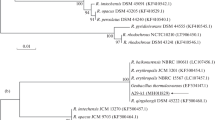Abstract
A wide range of fungi were tested for their ability to assimilate a series of hydrocarbons, which includedn-paraffins, aromatic hydrocarbons and petroleum fractions.
The property is not evenly distributed among the various fungal classes, but is to be found mainly in two orders, the Mucorales and the Moniliales. Within the latter order, the generaAspergillus andPenicillium are rich in hydrocarbon-assimilating strains. In other genera, the property of assimilating hydrocarbons is relatively rare.
Hydrocarbon assimilation is not necessarily common to related species, nor proper to one species, but more the property of individual strains. Different strains belonging to the same species differ in metabolic activity when they are tested against a series of hydrocarbons. The property of assimilating hydrocarbons appears to lack taxonomic value. Species of the same genus show only a tendency to behave in a similar way, e.g.Penicillium strains usually assimilaten-decane and light gas oil whereasAspergillus strains seldom do so.
Aspergillus species sporulate better on long chainn-paraffins. On some hydrocarbons, they develop particular pigments.
n-Paraffins with at least ten carbon atoms support better growth than petroleum fractions. Individual strains are very sensitive to minor changes in hydrocarbon composition or structure. Only sparse delayed growth is observed on aromatic hydrocarbons.n-Heptane, petroleum ether, naphtha and kerosene are often toxic whereas aromatic hydrocarbons are usually non-toxic.
Similar content being viewed by others
References
Ainsworth, G. C. 1961. Ainsworth and Bisby's dictionary of the fungi, 5th. ed., Commonwealth Mycological Institute, Kew (Surrey).
Baldacci, E. 1947 Olearia 1947: 90–95. Quoted by Zobell, C. E. 1950. Assimilation of hydrocarbons by microorganisms. Adv. Enzymology 10: 443–486.
Bilai, V. I., Pidoplichko, N. M., Gutyrya, V. S., Bukhalo, A. S., Vyun, A. A., Galich, P. N., Koval, E. Z., Masumyan, V. I. andMilko, A. A. 1965. Oil hydrocarbons as a source of carbon for soil mycelial microscopic fungi. Mikrobiol. Zh. (Ukr. R. S. R.)27: 3–10.
Böing, J. 1958. Schimmelbefall einer Paraffinemulsion. Zentr. Bakteriol. Parasitenk., II. Abt.111: 123–125.
Büttner, H. 1926. Zur Kenntnis der Mycobakterien, insbesondere ihres quantitativen Stoffwechsels auf Paraffinnährböden. Arch. Hyg.97: 125–127.
Edmonds, P. 1965. Selection of test organisms for use in evaluating microbial inhibitors in fuel-water systems. Appl. Microbiol.13: 823–824.
Fergus, C. 1966. Paraffin utilization by thermophilic fungi. Can. J. Microbiol.12: 1067–1068.
Flippin, R. S., Smith, C. andMickelson, M. N. 1964.Fusarium growth supported by hydrocarbons. Appl. Microbiol.12: 93–95.
Harris, J. O. 1957. Respiration studies of aMicrococcus capable of oxidizing hydrocarbons. Arch. Biochem. Biophys.70: 457–463.
Hodson, P. H. andDarlington, W. A. 1964. Dipicolinic acid formation from hydrocarbons by aPenicillium. J. Bacteriol.88: 803–804.
Hopkins, S. J. andChibnall, A. C. 1932. Growth ofAspergillus versicolor on higher paraffins. Biochem. J.26: 133–142.
Kester, A. S. 1962. Quoted by Foster, J. W. Hydrocarbons as substrates for microorganisms. Antonie van Lecuwenhock28: 241–274.
Krynitsky, J. A. andMcLaren, G. N. 1962. Some effects of microbial growth on surfactant properties of fuels. Biotechn. Bioengin.4: 357–367.
Leonard, J. M. andKlemme, D. E. 1962. Fungi in fuel. Report Naval Res. Lab. Progress, 1962, Sept. 1–8.
Miyoshi, M. 1895. Die Durchbohrung von Membranen durch Pilzfäden. Jahrb. Wiss. Botan.28: 269–289.
Nyns, E. J., Auquiere, J. P. andWiaux, A. L. 1967. Rapid screening for fungi capable of metabolizing hydrocarbons. 7th World Petroleum Congress. Mexico, VIII, p. 224. Elsevier ed., Amsterdam.
Rahn, O. 1906. Ein paraffin zersetzender Schimmelpilz Zentr. Bakteriol. Parasitenk. II. Abt.16: 382–384.
Raper, K. B. andFennell, D. I. 1965. The genusAspergillus. Williams and Wilkins, Baltimore.
Raper, K. B. andThom, Ch. 1949. A manual of the Penicillia. Williams and Wilkins, Baltimore.
Rynearson, T. K. andPeterson, J. L. 1965. Selective isolation of paraffinolytic fungi using a direct soil-baiting method. Mycologia57: 761–765.
Tausson, W. O. 1925. Zur Frage über die Assimilation des Paraffins durch Mikroorganismen. Biochem. Z.155: 356–368.
Tausson, W. O. 1928a. Über die Oxydation der Wachse durch Mikroorganismen. Biochem. Z.193: 85–93.
Tausson, W. O. 1928b. Bacterial oxydation of crude oils. Neftyanoe Khoz.14: 220–230.
Tausson, W. O. andTausson, T. A. 1933. Transformation of energy by microorganisms. II. Energetic correlations in paraffin and beeswax oxidation by mould. Microbiologyia2: 221–236.
Tausson, W. O. andVesselov, I. J. 1934. On the bacteriology of the decomposition of cyclical compounds at the reduction of sulphates. Mikrobiologyia3: 360–369.
Yamada, K. andTorigoe, Y. 1966. Utilization of hydrocarbons by microorganisms. 8. Screening of alkane assimilating fungi and their oxidation products from alkanes. J. Agric. Chem. Soc.40: 364–370.
Zaichenko, O. M. andKoval, E. Z. 1966a. The oxidation of some alkanes by the fungusPenicillium lanosum. Mikrobiol. Zh. (Ukr. R. S. R.)28: 10–15.
Zaichenko, O. M. andKoval, E. Z. 1966b. The oxidation of some alkanes by the fungusAspergillus terreus. Mikrobiol. Zh. (Ukr. R. S. R.)28: 8–10.
Zaichenko, O. M. andKoval, E. Z. 1966c. Oxidation of some alkanes byFusarium monilliforme Sheld. Mikrobiol. Zh. (Ukr. R. S. R.)28: 17–24.
Zikes, H. 1926. Beitrag zur Kenntnis Fett und Wachs zerstörender Pilze. Zentr. Bakteriol. Parasitenk. II. Abt.69: 161–163.
Author information
Authors and Affiliations
Rights and permissions
About this article
Cite this article
Nyns, E.J., Auquière, J.P. & Wiaux, A.L. Taxonomic value of the property of fungi to assimilate hydrocarbons. Antonie van Leeuwenhoek 34, 441–457 (1968). https://doi.org/10.1007/BF02046466
Received:
Published:
Issue Date:
DOI: https://doi.org/10.1007/BF02046466




